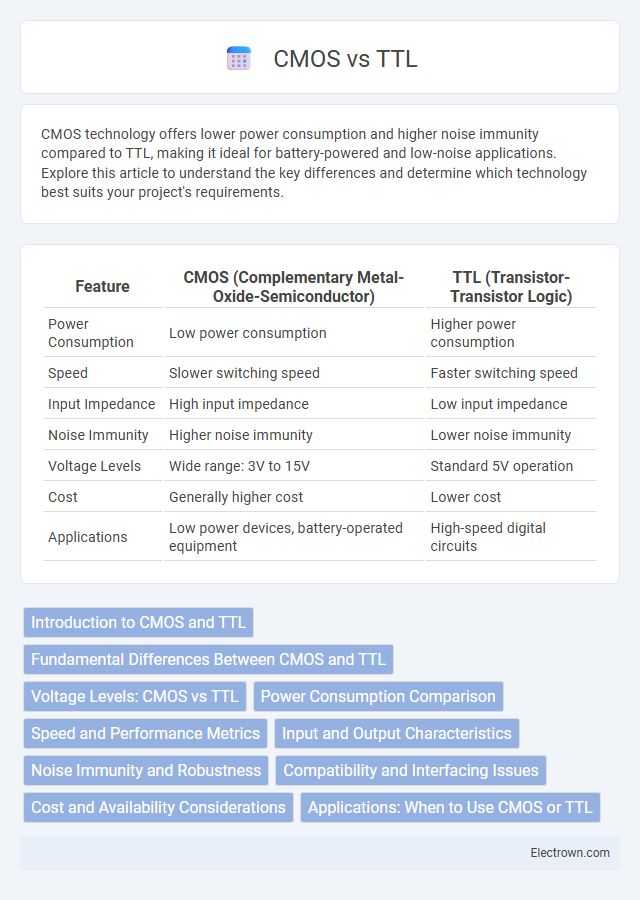CMOS technology offers lower power consumption and higher noise immunity compared to TTL, making it ideal for battery-powered and low-noise applications. Explore this article to understand the key differences and determine which technology best suits your project's requirements.
Table of Comparison
| Feature | CMOS (Complementary Metal-Oxide-Semiconductor) | TTL (Transistor-Transistor Logic) |
|---|---|---|
| Power Consumption | Low power consumption | Higher power consumption |
| Speed | Slower switching speed | Faster switching speed |
| Input Impedance | High input impedance | Low input impedance |
| Noise Immunity | Higher noise immunity | Lower noise immunity |
| Voltage Levels | Wide range: 3V to 15V | Standard 5V operation |
| Cost | Generally higher cost | Lower cost |
| Applications | Low power devices, battery-operated equipment | High-speed digital circuits |
Introduction to CMOS and TTL
CMOS (Complementary Metal-Oxide-Semiconductor) technology utilizes both p-type and n-type MOSFETs to achieve low power consumption and high noise immunity, making it ideal for modern integrated circuits. TTL (Transistor-Transistor Logic) relies on bipolar junction transistors (BJTs) for faster switching speeds but with higher power consumption compared to CMOS. The choice between CMOS and TTL impacts factors such as power efficiency, switching speed, and integration density in digital circuit design.
Fundamental Differences Between CMOS and TTL
CMOS (Complementary Metal-Oxide-Semiconductor) technology uses both p-type and n-type MOSFETs to create logic gates with significantly lower power consumption compared to TTL (Transistor-Transistor Logic), which relies on bipolar junction transistors. The fundamental difference lies in CMOS's high input impedance and low static power dissipation versus TTL's faster switching speed but higher power usage due to constant current flow in active states. CMOS circuits excel in battery-powered applications, while TTL remains favored for high-speed digital circuits despite consuming more power.
Voltage Levels: CMOS vs TTL
CMOS devices typically operate with a wider voltage range, usually from 3V to 15V, making them more flexible for different power supplies, while TTL circuits commonly run at a fixed 5V. The input voltage threshold for CMOS is usually around half the supply voltage, whereas TTL logic levels are defined rigidly with a low voltage below 0.8V and a high voltage above 2.0V. Your choice between CMOS and TTL should consider these voltage level differences for compatibility and power efficiency in your electronic designs.
Power Consumption Comparison
CMOS technology significantly outperforms TTL in power efficiency, consuming substantially less power due to its high input impedance and low static current draw. This makes CMOS ideal for battery-operated devices where minimal power consumption extends your device's operational life. TTL circuits typically draw continuous current, leading to higher power dissipation and less energy-efficient designs.
Speed and Performance Metrics
CMOS technology offers higher speed and lower power consumption compared to TTL due to its complementary transistor design and reduced static current flow. TTL circuits, while traditionally faster in switching times, typically consume more power and generate more heat, which can impact overall performance in high-density applications. Your choice between CMOS and TTL should consider speed requirements and performance metrics such as propagation delay and power efficiency for optimal system design.
Input and Output Characteristics
CMOS devices exhibit high input impedance, typically in the range of megaohms to gigaohms, resulting in very low input current and minimal loading on preceding circuits. TTL devices have lower input impedance, usually around a few kiloohms, causing higher input current and more noticeable loading effects. CMOS outputs can both source and sink substantial current with symmetrical characteristics, while TTL outputs are better at sinking current than sourcing, influencing design choices in driving loads and interfacing circuits.
Noise Immunity and Robustness
CMOS technology exhibits superior noise immunity compared to TTL, with typical noise margins of 0.3 to 0.4 times the supply voltage, enabling stable operation in noisy environments. TTL circuits generally have lower noise margins (around 0.2 times the supply voltage), making them more susceptible to interference and voltage fluctuations. The high input impedance and reduced power consumption of CMOS further enhance its robustness in industrial and low-power applications.
Compatibility and Interfacing Issues
CMOS and TTL logic families differ significantly in their input and output voltage levels, affecting direct compatibility and requiring level shifting circuits for proper interfacing. TTL devices typically operate at 5V with input logic thresholds around 0.8V for low and 2.0V for high, whereas CMOS devices have wider voltage ranges, often from 3V to 15V, with thresholds near half the supply voltage. To ensure reliable communication between CMOS and TTL components in your projects, consider using interface circuits like open-drain buffers or voltage translators to prevent signal distortion and damage.
Cost and Availability Considerations
CMOS technology generally offers lower manufacturing costs and higher availability due to its widespread use in modern integrated circuits and lower power consumption requirements. TTL components tend to be more expensive and less readily available as they are considered legacy technology, with fewer suppliers producing these parts. Cost-effectiveness and supply chain stability make CMOS the preferred choice for most contemporary electronic designs.
Applications: When to Use CMOS or TTL
CMOS technology is preferred in battery-powered devices and portable electronics due to its low power consumption and high noise immunity. TTL is ideal for high-speed digital circuits and systems requiring fast switching times, such as computer motherboards and industrial control applications. Selecting CMOS or TTL depends on power efficiency needs versus speed and noise tolerance requirements in specific electronic designs.
CMOS vs TTL Infographic

 electrown.com
electrown.com